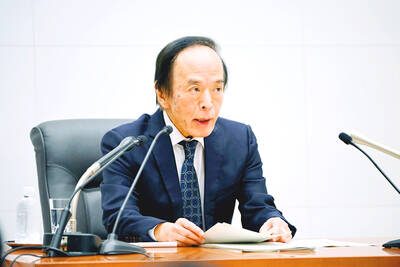The nation’s electrical engineering and machinery industry could consider Southeast Asia as a market for new demand, the Taiwan Institute of Economic Research (TIER, 台灣經濟研究院) said last week.
Given the region’s stable economic growth, demand from Southeast Asian countries would be more favorable in the long term, TIER senior analyst Wang Chung-ching (王忠慶) told a seminar organized by Taiwan Stock Exchange Corp (台灣證券交易所) on Wednesday.
As demand in Taiwan is unlikely to increase significantly in the near future, manufacturers need to seek new sales drivers in emerging markets while the government could help manufacturers find new buyers via existing channel networks, as many Taiwanese companies have operated in Southeast Asia for years, Wang said.
Taiwan’s exports of machinery equipment dropped 6.9 percent to US$19.4 billion last year from a year earlier, the fourth consecutive year of decline, data compiled by the Taiwan Association of Machinery Industry (TAMI, 台灣機械工業同業公會) showed.
Shipments to China and the US, the top two markets for local machinery makers, declined by 12.7 percent and 0.6 percent year-on-year last year respectively, TAMI’s data showed.
China was the destination for about 26 percent of all Taiwanese machinery exports last year, followed by the US, with 17.9 percent, while Southeast Asia accounted for 16.7 percent or US$3.24 billion, the TAMI data showed.
“The machinery industry’s exports have been stagnant since 2011, mainly dragged down by the sluggish demand after the global financial crisis [2008 to 2009],” Wang said, adding that challenges also comes from the supply side.
Local manufacturers face a rising competition from their global peers, such as Germany and China, who have used new technologies to enhance their capabilities.
Germany, which initiated the idea of “Industry 4.0” in 2011, has extended its focus to the computerization of manufacturing process in all its industrial sectors, Wang said.
Foreign exchange fluctuation is another drag on Taiwan’s exports, he said.
The dramatic depreciation of China’s yuan against major global currencies significantly hurt the industry last year, he added.
Local manufacturers should boost their niches in the global market through product differentiation, he said.
“Most machinery companies only provide individual machines or components. They should try to develop total solutions for end-market customers,” he said.
To raise the competitiveness of the nation’s traditional industries, the Taiwan Machine Tool & Accessory Builders’ Association (台灣工具機暨零組件工業同業公會) has said that it is seeking to cooperate with companies in different fields, including the semiconductor industry, to differentiate their products from those of their rivals.

Taiwan Semiconductor Manufacturing Co (TSMC, 台積電) last week recorded an increase in the number of shareholders to the highest in almost eight months, despite its share price falling 3.38 percent from the previous week, Taiwan Stock Exchange data released on Saturday showed. As of Friday, TSMC had 1.88 million shareholders, the most since the week of April 25 and an increase of 31,870 from the previous week, the data showed. The number of shareholders jumped despite a drop of NT$50 (US$1.59), or 3.38 percent, in TSMC’s share price from a week earlier to NT$1,430, as investors took profits from their earlier gains

In a high-security Shenzhen laboratory, Chinese scientists have built what Washington has spent years trying to prevent: a prototype of a machine capable of producing the cutting-edge semiconductor chips that power artificial intelligence (AI), smartphones and weapons central to Western military dominance, Reuters has learned. Completed early this year and undergoing testing, the prototype fills nearly an entire factory floor. It was built by a team of former engineers from Dutch semiconductor giant ASML who reverse-engineered the company’s extreme ultraviolet lithography (EUV) machines, according to two people with knowledge of the project. EUV machines sit at the heart of a technological Cold

TAIWAN VALUE CHAIN: Foxtron is to fully own Luxgen following the transaction and it plans to launch a new electric model, the Foxtron Bria, in Taiwan next year Yulon Motor Co (裕隆汽車) yesterday said that its board of directors approved the disposal of its electric vehicle (EV) unit, Luxgen Motor Co (納智捷汽車), to Foxtron Vehicle Technologies Co (鴻華先進) for NT$787.6 million (US$24.98 million). Foxtron, a half-half joint venture between Yulon affiliate Hua-Chuang Automobile Information Technical Center Co (華創車電) and Hon Hai Precision Industry Co (鴻海精密), expects to wrap up the deal in the first quarter of next year. Foxtron would fully own Luxgen following the transaction, including five car distributing companies, outlets and all employees. The deal is subject to the approval of the Fair Trade Commission, Foxtron said. “Foxtron will be

INFLATION CONSIDERATION: The BOJ governor said that it would ‘keep making appropriate decisions’ and would adjust depending on the economy and prices The Bank of Japan (BOJ) yesterday raised its benchmark interest rate to the highest in 30 years and said more increases are in the pipeline if conditions allow, in a sign of growing conviction that it can attain the stable inflation target it has pursued for more than a decade. Bank of Japan Governor Kazuo Ueda’s policy board increased the rate by 0.2 percentage points to 0.75 percent, in a unanimous decision, the bank said in a statement. The central bank cited the rising likelihood of its economic outlook being realized. The rate change was expected by all 50 economists surveyed by Bloomberg. The